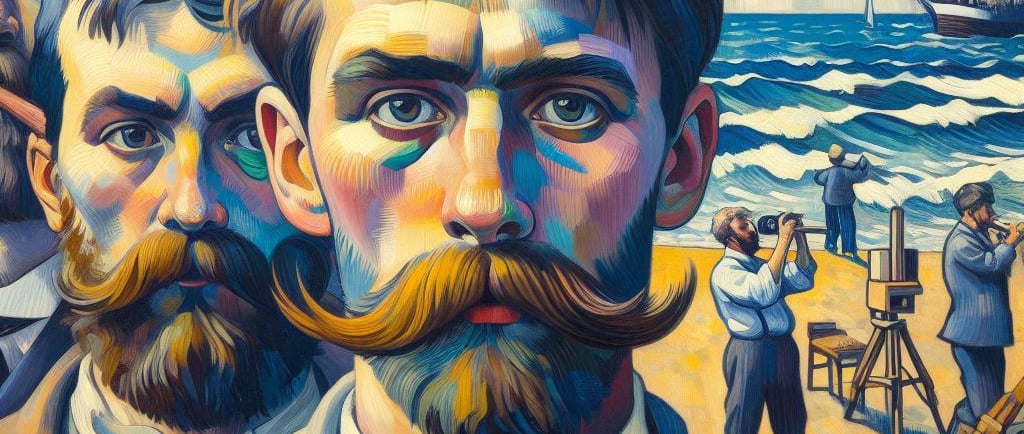Fauvism: The Freedom of Color
Fauvism, an early 20th-century art movement, is renowned for its bold use of color and expressive brushwork. Key figures like André Derain, Henri Matisse, and Maurice de Vlaminck revolutionized art by using vibrant, non-naturalistic colors to convey emotion and atmosphere. Derain's dynamic landscapes, Matisse's harmonious compositions, and Vlaminck's intense, primary-colored works each contributed uniquely to the movement. Despite its brief existence, Fauvism's impact on modern art is profound, influencing countless contemporary artists. This movement celebrates the freedom of artistic expression through color, leaving a lasting legacy in the art world.
Team Fossoria
11/6/20242 min read


Fauvism, a revolutionary art movement that emerged in the early 20th century, is celebrated for its bold use of color and expressive brushwork. The term "Fauvism" comes from the French word "fauves," meaning "wild beasts," a name coined by art critic Louis Vauxcelles due to the movement's vibrant and unconventional style. This movement was spearheaded by a group of artists who sought to break free from traditional artistic norms and explore the emotional power of color. Among the most notable Fauvist artists were André Derain, Henri Matisse, and Maurice de Vlaminck, each of whom made significant contributions to the movement while maintaining distinct individual styles.
André Derain: The Pioneer of Fauvism
André Derain was a key figure in the Fauvist movement, known for his daring use of color and innovative techniques. Derain's work is characterized by its vivid, pure colors and dynamic compositions. He often painted landscapes and cityscapes, transforming them into vibrant, almost abstract forms. One of his most famous works, "Charing Cross Bridge" (1906), exemplifies his ability to use color to convey mood and atmospherehttps://www.britannica.com/biography/Andre-Derainhttps://artincontext.org/andre-derain/. Derain's contribution to Fauvism was not only in his paintings but also in his role as a co-founder of the movement alongside Henri Matisse. His early works laid the foundation for the Fauvist style, influencing many of his contemporaries.
Henri Matisse: The Master of Color
Henri Matisse is often regarded as the leader of the Fauvist movement. His approach to color was both radical and influential, using it not just to depict reality but to express emotion and create harmony within his compositions. Matisse's famous painting "Woman with a Hat" (1905) shocked the art world with its bold, non-naturalistic colors and loose brushwork. Matisse believed that color could be used to convey the artist's feelings and to evoke a response from the viewer. His work emphasized the importance of personal expression and the emotional impact of color, which became central themes in Fauvism.
Maurice de Vlaminck: The Wild Beast
Maurice de Vlaminck, known for his brash temperament and bold style, was another prominent Fauvist artist. Vlaminck's paintings are characterized by their intense, vibrant colors and expressive brushwork. He often used primary colors straight from the tube, creating a sense of raw energy and spontaneity in his works. Vlaminck's landscapes and cityscapes, such as "Tugboat on the Seine, Chatou" (1906), are notable for their dynamic compositions and emotional intensity. His approach to color and form was more radical than that of his fellow Fauves, pushing the boundaries of traditional painting and paving the way for future avant-garde movements.
Differences and Contributions
While Derain, Matisse, and Vlaminck shared a common goal of exploring the expressive potential of color, their individual styles and contributions to Fauvism were distinct. Derain's work often focused on the interplay of light and color, creating vibrant, atmospheric landscapes. Matisse, on the other hand, used color to convey emotion and harmony, emphasizing the importance of personal expression. Vlaminck's paintings were marked by their raw energy and bold use of primary colors, reflecting his intense and impulsive approach to art.
Together, these artists helped to define Fauvism as a movement that celebrated the freedom of using color in new and expressive ways. Their innovative techniques and bold styles challenged traditional artistic conventions and left a lasting impact on the trajectory of modern art.
Fauvism may have been a short-lived movement, but its influence can still be seen in the works of many contemporary artists who continue to explore the emotional power of color. The legacy of Derain, Matisse, and Vlaminck lives on, reminding us of the boundless possibilities of artistic expression.
